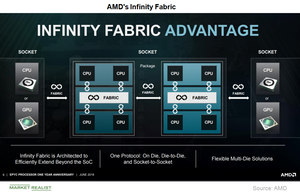What’s AMD’s Product Execution Strategy?

Moore’s Law, in which every node shrink improves performance and efficiency, is slowing, and the growing demand for efficiency and performance has called for the need to go beyond Moore’s Law. Advanced Micro Devices (AMD) and Intel (INTC) are doing so using heterogeneous computing. AMD uses Infinity Fabric technology that interconnects its CPUs (central processing units), GPUs (graphics processing units), I/O (input/output) path, and memory.

 Yahoo Finance
Yahoo Finance 